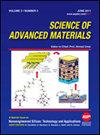Effects of Recepteur D’origine Nantais/Phosphatidylinositol 3 Kinase Pathway Mediated by Polymer Biodegradable Sustained-Release Materials on Proliferation and Apoptosis of Uterine Fibroids
IF 0.9
4区 材料科学
引用次数: 0
Abstract
This research was aimed to investigate the effects of biodegradable letrozole (LE) sustained release (SR) polymer material on the biological behavior of uterine fibroids (UFs) and RON/PI3K signaling pathway (SPW). Poloxamer 188 (P188) and poly L lactide acid (PLLA) were selected to prepare the degradable SR electrospinning (ES) materials LE/P188/PlLA-1 (LE concentration: 6.25%), LE/P188/PLLA-2 (LE concentration: 12.25%), and LE/P188/PLLA-3 (LE concentration: 25%) with different concentrations of LE. UF cells were then co-cultured with free LE and degradable SR ES materials. Cell proliferation and apoptosis were detected by MTT and flow cytometry, respectively. The expression changes of apoptosis-related proteins (Bcl-2, Bax, and caspase-3), epithelial-mesenchymal transition (EMT)-related proteins (E-cadherin, N-cadherin, Vimentin), and RON/PI3K SPW-related proteins (RON and PI3K) were detected by western blot. The average diameter of LE/P188/PLLA-1, LE/P188/PLLA-2, and LE/P188/PLLA-3 were (145.6±20.8) nm, (158.1±16.3) nm, and (173.4±20.1) nm, respectively. Moreover, it possessed the obvious characteristics of LE, P188, and PLLA. LE/P188/PLLA-3 had the lowest SR rate of LE but the longest SR duration. Compared with normal cells, the proliferation inhibition rate (PIR) and apoptosis rate (AR) of LE and its degradable SR ES materials were increased ( P <0.05). While expressions of Bax, caspase-3, E-cadherin, and PI3K were increased, Bcl-2, N-cadherin, Vimentin, and RON were decreased ( P <0.05). In contrast to the free LE, the cell proliferation inhibition rate (PIR) and apoptosis promotion rate (APR) of LE degradable SR ES materials were increased, the levels of Bax, caspase-3, E-cadherin, and PI3K were increased, and the levels of Bcl-2, N-cadherin, Vimentin, and RON were decreased ( P <0.05). The results herein were concentration-dependent. The preparation of LE degradable SR ES materials with P188/PLLA can improve the therapeutic effect of LE. LE degradable SR ES materials can effectively inhibit the proliferation of UFs, promote cell apoptosis, inhibit its EMT process and activation of RON/PI3K SPW in a concentration-dependent manner.高分子生物可降解缓释材料介导的原受体南太/磷脂酰肌醇3激酶通路对子宫肌瘤增殖和凋亡的影响
本研究旨在探讨可生物降解来曲唑(LE)缓释高分子材料对子宫肌瘤(UFs)生物学行为及RON/PI3K信号通路(SPW)的影响。选择poloxam188 (P188)和聚L乳酸(PLLA)制备了不同LE浓度的可降解SR静电纺丝(ES)材料LE/P188/PLLA- 1 (LE浓度为6.25%)、LE/P188/PLLA-2 (LE浓度为12.25%)和LE/P188/PLLA-3 (LE浓度为25%)。然后将UF细胞与游离LE和可降解SR ES材料共培养。MTT和流式细胞术分别检测细胞增殖和凋亡情况。western blot检测凋亡相关蛋白(Bcl-2、Bax、caspase-3)、上皮-间质转化(EMT)相关蛋白(E-cadherin、N-cadherin、Vimentin)、RON/PI3K spw相关蛋白(RON、PI3K)的表达变化。LE/P188/PLLA-1、LE/P188/PLLA-2和LE/P188/PLLA-3的平均直径分别为(145.6±20.8)nm、(158.1±16.3)nm和(173.4±20.1)nm。具有明显的LE、P188和PLLA特征。LE/P188/PLLA-3的生长率最低,但生长期最长。与正常细胞相比,LE及其可降解SR - ES材料的增殖抑制率(PIR)和凋亡率(AR)均升高(P <0.05)。Bax、caspase-3、E-cadherin、PI3K表达升高,Bcl-2、N-cadherin、Vimentin、RON表达降低(P <0.05)。与游离LE相比,LE可降解SR ES材料的细胞增殖抑制率(PIR)和细胞凋亡促进率(APR)升高,Bax、caspase-3、E-cadherin、PI3K水平升高,Bcl-2、N-cadherin、Vimentin、RON水平降低(P <0.05)。本研究结果具有浓度依赖性。用P188/PLLA制备LE可降解SR ES材料可以提高LE的治疗效果。LE可降解SR ES材料能有效抑制UFs的增殖,促进细胞凋亡,抑制其EMT过程和RON/PI3K SPW的激活,并呈浓度依赖性。
本文章由计算机程序翻译,如有差异,请以英文原文为准。
求助全文
约1分钟内获得全文
求助全文
来源期刊

Science of Advanced Materials
NANOSCIENCE & NANOTECHNOLOGY-MATERIALS SCIENCE, MULTIDISCIPLINARY
自引率
11.10%
发文量
98
审稿时长
4.4 months
 求助内容:
求助内容: 应助结果提醒方式:
应助结果提醒方式:


